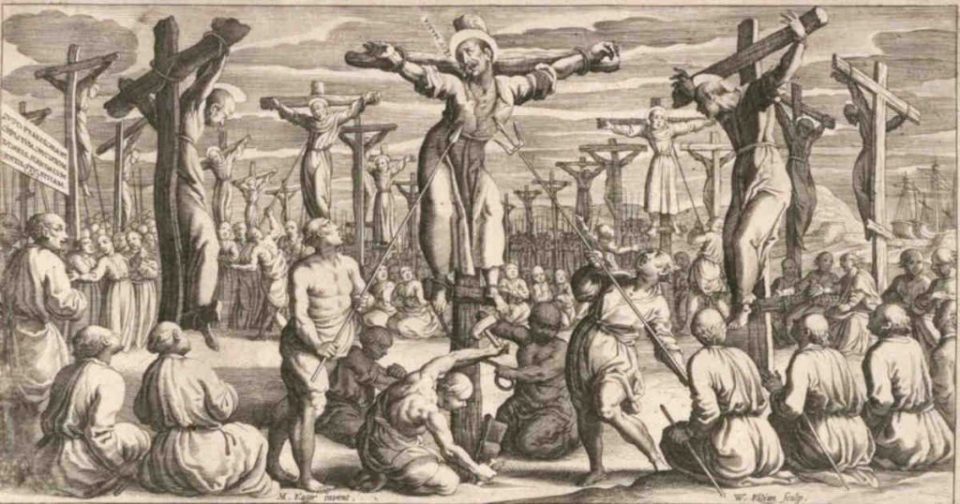Life of Saints: St. Paul Miki and companions

Saints Paolo Miki and companions, martyrs
c. 1562-1597; late XNUMXth century
February 6 - Memorial (Optional memorial for Lent day)
Liturgical color: Red (Violet if the day of the week of Lent)
Patron Saints of Japan
Native Japanese priests and lay people die nobly for a new faith
The words of the American poet John Greenleaf Whittier capture the pathos of today's memorial: "For all the sad words of language or pen, the saddest are these:" It could have been! "The rapid rise and fall of Catholicism in Japan is one of the great" powerful "in human history. Portuguese and Spanish priests, mostly Jesuits and Franciscans, brought the highly cultured Catholic religion to the island of Japan in the late 1500s with great success. Tens of thousands of people converted, two seminars were opened, the Japanese natives were ordained priests and Japan ceased to be mission territory, being elevated to a diocese. But the growing arc of missionary success curled just as quickly downward. In waves of persecutions from 1590 to 1640, thousands of Catholics were persecuted, tortured and executed until the Catholic religion, and indeed any outward expression of Christianity, was completely eradicated. Japan has almost become a Catholic nation, approaching to join the Philippines as the only fully Catholic society in Asia. Japan could have done for Asia in 1600 what Ireland did for Europe in the early Middle Ages. He could have sent missionary scholars, monks, and priests to convert far greater nations than himself, including China. It was not meant to be. and missionary priests to convert nations far greater than itself, including China. It was not meant to be. and missionary priests to convert nations far greater than itself, including China. It was not meant to be.
Paul Miki was a Japanese native who became a Jesuit. The Jesuits would not accept men from India or other nations they considered inferior in education and culture into their seminary. But the Jesuits had immense respect for the Japanese, whose culture was equal to or even superior to that of Western Europe. Paul Miki was among those who, after being educated in the faith, evangelized their people in their own language. He and others have traced a new path forward, allowing the Japanese not only to understand but to see, in flesh and blood, that they could preserve the best of their native culture while being faithful to the rediscovered God of Jesus Christ.
Paul, a Jesuit brother, and his companions were the first group to suffer mass martyrdom in Japan. A military leader and adviser to the emperor feared the Spanish and Portuguese conquest of the island and ordered the arrest of six Franciscan priests and brothers, three Japanese Jesuits, sixteen other Japanese and one Korean. The arrested had mutilated the left ear and were therefore forced to march, bloody, hundreds of miles to Nagasaki. On February 5, 1597, Paul and his companions were tied to crosses on a hill, like Christ, and pierced by spears. An eyewitness described the scene:
Our brother, Paul Miki, saw himself standing on the noblest pulpit he had ever filled. At his "congregation" he began by proclaiming himself Japanese and Jesuit ... "My religion teaches me to forgive my enemies and all those who have offended me. Please excuse the Emperor and all those who sought my death. I ask them to seek baptism and to be Christians themselves. " Then he looked at his companions and began to encourage them in their final fight ... So, according to Japanese custom, the four executioners began to draw their spears ... The executioners killed them one by one. A push from the spear, then a second hit. It ended quickly.
The executions did nothing to stop the Church. The persecution only fueled the flames of faith. In 1614 about 300.000 Japanese were Catholics. Then more intense persecutions followed. Japanese leaders eventually chose to isolate their ports and borders from practically any foreign penetration, a policy that would last until the nineteenth century. Only in 1854 was Japan forcibly open to foreign trade and western visitors. Hence, thousands of Japanese Catholics suddenly came out of hiding, mostly near Nagasaki. They bore the names of Japanese martyrs, spoke a little Latin and Portuguese, asked their new guests for the statues of Jesus and Mary and tried to verify whether a French priest was legitimate with two questions: 1) Are you celibate? and 2) do you come to the Pope in Rome? These hidden Christians also opened their palms to show the priest something else: the relics of the martyrs that their remote ancestors had known and honored centuries earlier. Their memory was never dead.
St. Paul Miki, you have accepted martyrdom rather than abandoning your faith. You have chosen to serve those closest to you rather than flee. Inspire in us the same love of God and man so that we too can know, love and serve God in the heroic way that made you so brave and composed in the face of intense suffering.